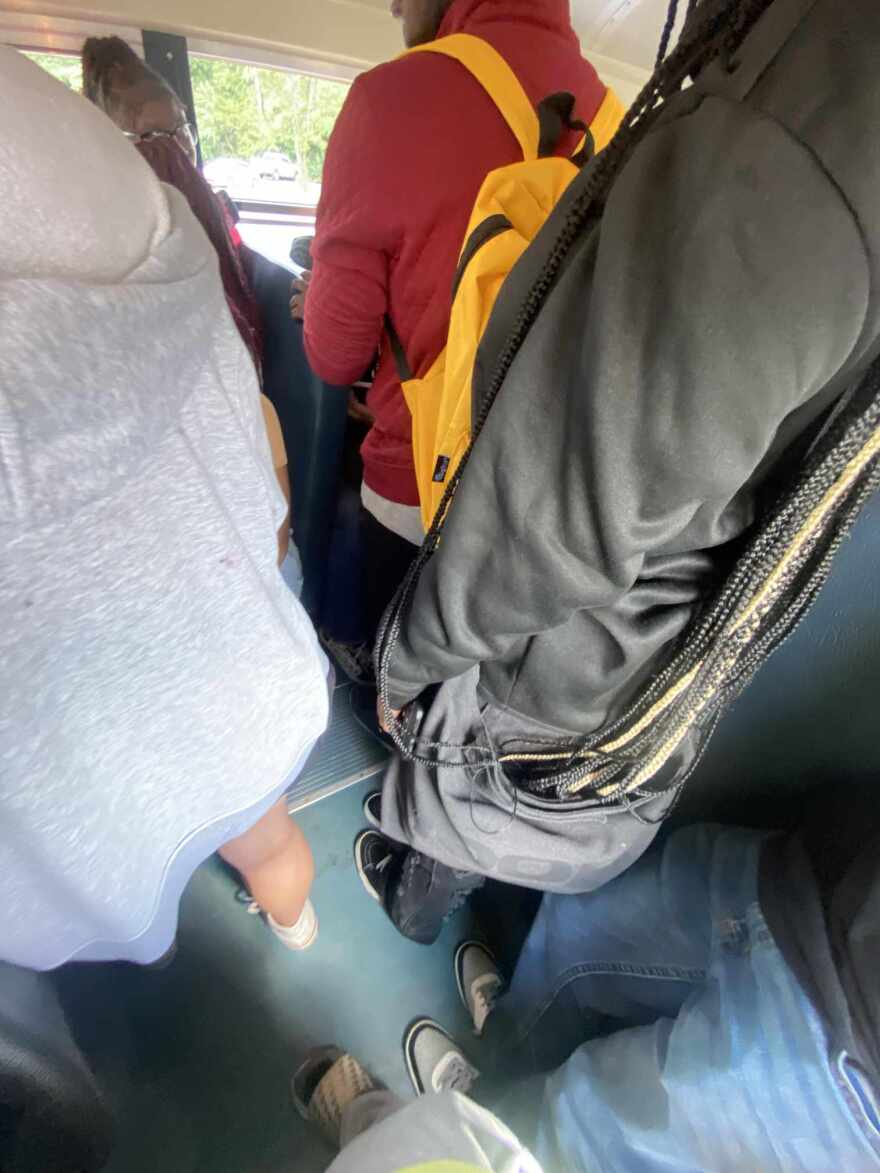On the first day of school, Jeffersontown High School student Chayley Williams squeezed onto her afternoon bus with dozens of other kids: too many — Williams thought. She listened as a staff member counted the students on board and said he got to 85. The bus was only meant to hold a maximum of 66 students.
“The whole time we were saying that it was way too crowded,” she said. “We were asking if they could get us another bus to, like, split it up, but they just said we have to go home like this if we want to go home.”
The driver wouldn’t leave until everyone sat down, Williams said. So she sat in the only place available: another student’s lap. There were already four students in the seat.
“There was three people sitting in the seat, and then two people on laps,” Williams said.
Williams said sitting in the lap of a girl she didn’t know made her “uncomfortable.” When school restarted on Aug. 21, she opted to take a TARC. The city bus took about as long to get home, but it was less crowded and had air conditioning, unlike her school bus.
By Friday of that week, she tried the bus again, hoping the district would have worked out the kinks. But it was still too crowded, Williams said, with three students to a seat and some standing in the aisles.
Williams spent the ride standing in front of the exit door. She said she felt “not safe.”

“I feel that she should have a way to safely get to and from school,” her mother Heather Williams said. “I don’t think that the capacity going that far over is safe — if they got into an accident or if there were a fire.”
According to the National Highway Traffic Safety Administration there is no federal regulation specifying the number of people who can sit in a school bus seat.
“School transportation providers generally determine the number of people they can safely fit into a school bus seat. Generally, they fit three smaller elementary school students or two adult high school students into a typical 39-inch school bus seat,” the NHTSA website says.
Federal regulation does require that school buses are engineered to provide crash protection without seatbelts. That protection comes in part from the design of the seats.
The NHTSA warns that students who are not sitting fully within a seat “will not be afforded the occupant protection provided by the school bus seats.”
Responding to an inquiry from LPM News sent Aug. 30, Jefferson County Public Schools spokesperson Mark Hebert said there are between 65 and 70 students riding Williams’ bus home “on a normal afternoon.”
The bus has a maximum capacity of 66 students, with three to a seat. That means on an average day, some students would have been forced to stand in the aisle or sit on another person’s lap.
“There is a plan going into effect as early as this afternoon [Tuesday, Sept. 5], to shift some of Bus #1841’s stops to another bus that runs an adjacent route and has capacity for more students,” Hebert wrote.
JCPS Superintendent Marty Pollio told LPM News the district had identified about 50 buses that were at capacity as of Aug. 29.
“That requires, many times, three to a seat,” he said. “Sometimes students may not want to do that, and they stand up instead.”
Asked about the protocol if a bus is over capacity, Pollio said school staff are “supposed to count.”
“We will, if we need to, send out a second bus,” he said. Weeks into the school year, that appears not to have happened yet for Williams’ bus.
Asked about the delay, Hebert said JCPS Transportation Director Marcus Dobbs “is not aware of any complaints from students or parents about overcrowding on that afternoon bus.”
“It’s not unusual for adjustments to be made in the first few weeks of school once there is a clearer picture of the ridership on each bus. This year there are more adjustments being made because of the shortage of drivers, and new and longer routes transporting the same number of students,” Hebert wrote.
Going forward, with the current shortage of bus drivers, Pollio said the only solution to reduce crowding is to reduce ridership.
In a school board meeting Aug. 29, the superintendent told board members as much.
"If we want to make sure that bus rides are short, buses are not overcrowded, then we are going to have to make some tough decisions about who gets transportation and who doesn't," he said.
The board’s next meeting is Sept. 26. That’s when the board will continue discussions about possible solutions.
Until her bus is less crowded, Williams said she’ll continue to ride the TARC, even if it means spending almost $4 a day to get home from school.
This story was updated to correct the name of JCPS' transportation director.
Support for this story was provided in part by the Jewish Heritage Fund.






